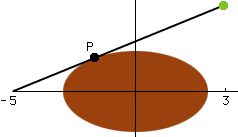Hello, i'm a teacher in Dallas, Texas and a student asked me to help her with these problems and I'm stuck. Any help you could give would be great.
Thanks
Question #1
I've set up a ratio and tried to find the constant but am stuck.
The picture shows an x and y axis with only the points -5 and 3 written on the x axis. the lamp is on the upper right quadrant shining down diagonally to the left. There's an ellipse around the origin creating the shadow. It's formula is given as x^2 + 4y^2=5.
Hi
For the first problem the volume of a sphere is


 minutes.
minutes. For the second problem I have the diagram

The crutial point here is that the line from the light to the point (-5,0) is tangent to the ellipse at the point I have called P. What you need to do is find P, write the equation, y = mx + b, of the tangent line and then substitute x = 3 to find the height of the light.
Let the point P have first coordinate a then its second coordinate is ![]() (take the positive square root since the second coordinate is clearly positive). Either solve the equation of the ellipse and differentiate or differentiate implicitly to find that the slope of the tangent line at P is
(take the positive square root since the second coordinate is clearly positive). Either solve the equation of the ellipse and differentiate or differentiate implicitly to find that the slope of the tangent line at P is ![]() . Since the tangent line passes through (-5,0) and P you can also find the slope using the "rise-over-the-run" expression. This leads to
. Since the tangent line passes through (-5,0) and P you can also find the slope using the "rise-over-the-run" expression. This leads to

Solving for a gives a = -1. Now substitute a = -1 into the expression for the slope, write the equation of the tangent line and substitute x = 3.
Cheers,
Harley